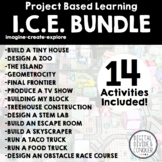

The Teacher-Author indicated this resource includes assets from Google Workspace (e.g. docs, slides, etc.).
This was a great culminating project to end the unit. Very hands on and my students paid very close attention to all the details of their designs. Thank you!
Rated 5 out of 5My students loved making this project! The project was a great way to combine 2D and 3D shape learning.
Rated 5 out of 5 See all reviews
This bundle includes fourteen project based learning activities that focus on a variety of cross-curricular skills These PBL’s focus on a variety of cross-curricular skills and still take your students on adventures that they will never forget, even though they'll still be in the classroom. These
$74.95 Price $74.95 $92.00 Original Price $92.00 Save $17.05 View Bundle
If you’ve been watching TV or reading magazines, chances are you've seen a tiny house. These little homes are everywhere. and now, we're asking students to make their own 3D version!
Build A Tiny House is a project based learning (PBL) activity that'll put the designing into the hands of the students. Students will dive deep to show they understand the how (and why) math concepts such as area, perimeter, and geometry are used in building a home. This project integrates multiple elements such as problem solving, collaboration, design, and planning that connect concepts across multiple platforms.
***THIS RESOURCE IS NOW DIGITAL!***
There is a link to a Google Slides Version. Details below.
The objective of this project is for students to design and build a TINY HOUSE, while applying area, perimeter, and geometry skills. This project based learning activity also focuses on designing elements, using multiple problem solving skills, and collaborating in the classroom. It allows for easy differentiation, so students can work at a pace they will be successful at.
With this resource students WILL CREATE a miniature 3D version of a tiny house. The size of the houses will all be the same, but each student will create a unique version based on their own ideas, imagination, and application of skills.
Build a Tiny House asks students if they can design a house that contains almost 20 different pieces of furnishings (all in one place) and then find the area and perimeter of each item after they have done so. They’re also asked to apply geometric skills; such as shapes and even developing their own nets to create furniture.
What's included:
6 About this Resource
8 Cover Page and Introduction
13 Tiny House Parts
18 Final Version of House and Requirement List
22 Spec Home 1 and 2
25 Exterior Design
27 Building Furniture (optional)
32 Housing Problems (optional)
37 Spec Homes (extra versions)
42 Extra Pieces
46 Teacher Rubrics
49 Making A Tiny House Projectable Page (with images)
Below are the specific TASKS students will be completing.
Read ALL the directions in TINY HOUSE PARTS.
VERY IMPORTANT! >>>> Refer back to them as much as you need.
SECOND: Rough Draft
Create a rough draft of your tiny house and include all items on the requirements list.
THIRD: Final Version
Create a final version of the tiny house. There are 4 pages for the Base, Walls, and Roof. Check off each item from the requirement list.
FOURTH: Spec Home 1
Record the area, perimeter, and geometric shape of each item from the requirement list.
FIFTH: Spec Home 2
Record the area and perimeter of the major sections of the house (base, walls, roof/ceiling).
SIXTH: Build the House
Cut out each of the four sections of the house and fit them together.
Continue your design and decorate the outside of your house.
Answer questions about the house design and reflect on your creation.
NINTH: Building Furniture
OPTIONAL: Create 3D nets of furnishings in your house. There is a page included or you may use graph paper included.
TENTH: Housing Problems
OPTIONAL: Create area and perimeter word problems for your house and have other students solve them.
***THIS RESOURCE IS NOW DIGITAL!***
Included is an 18 slide interactive resource for students to create a tiny house with a focus on area, perimeter, and geometry skills. This does NOT include all the pages of this resource.
The Digital LINK is on PAGE 64.
Project Introductions and instructions.
Students create the interiors of their tiny house (floor, walls, ceiling)
Scoring rubric for students
Photographs of what the inside of a tiny house can look like.
-There are text boxes for all place that can be filled.
-For ALL places that require designing- students may use the SHAPE, LINE, TEXT BOX, or even include an IMAGE.
-Students may print out the FINAL VERSION blueprints to create a 3D version if they have access to a printer.
TEACHER INSTRUCTIONS FOR GOOGLE SLIDES
Before you begin editing/filling in your project, it is to first , on your own Google Drive.
After creating a copy of the resource you can decide which slides you would like to include and which ones to delete before you assign this as an assignment.
This PBL activity focuses on the real-world application of math concepts used in building and designing homes, while practicing problem-solving skills (which are one of the most sought after skills in the work force today), collaboration, and using their imagination.
UNIT MEASUREMENT: The measurement used for this project will be a single unit per cube. You may choose to increase complexity by making each cube worth more. Use this with students to easily differentiate.
Example: 1 square = 3 units or 1 square = 5 units
There are no feet, yard, or meters.
-card stock (optional for the
-crayons and colored pencils
The time frame for completing this project will vary greatly. If you are planning on completing it in a week, give 45-60 minutes per day.
All students will work at different rates, but by the end of the week students should be finishing the required steps (1-8) or trying some of the additional tasks.
-books or magazines on building houses
-videos that show tiny houses from
internet (or maybe a HGTV show)
-videos that merge math and housing
together (search Youtube)
Push your students to try new ideas. At the beginning they may be hesitant, but encourage them to try new ideas. There are unlimited options in the project.
See More Projects in my custom category:
MORE LIKE THIS: